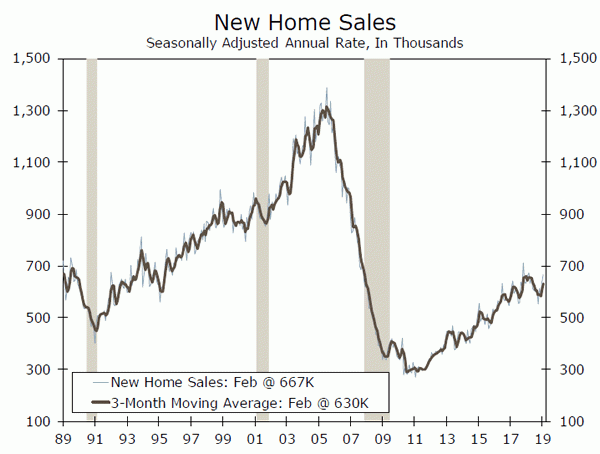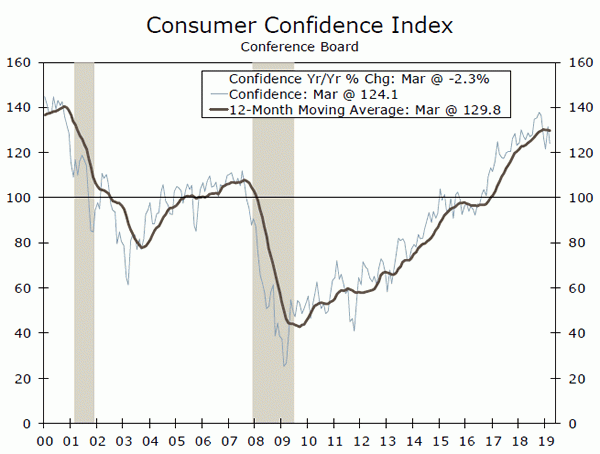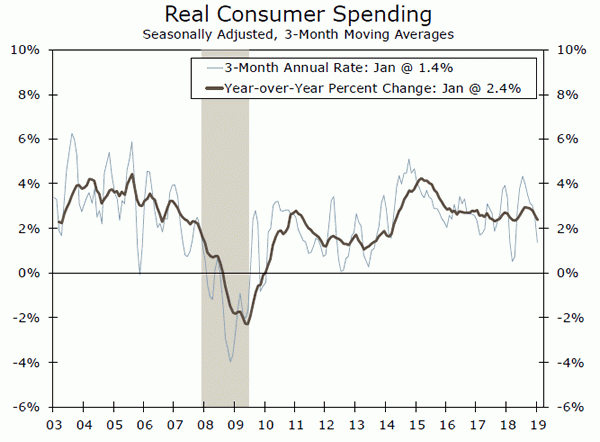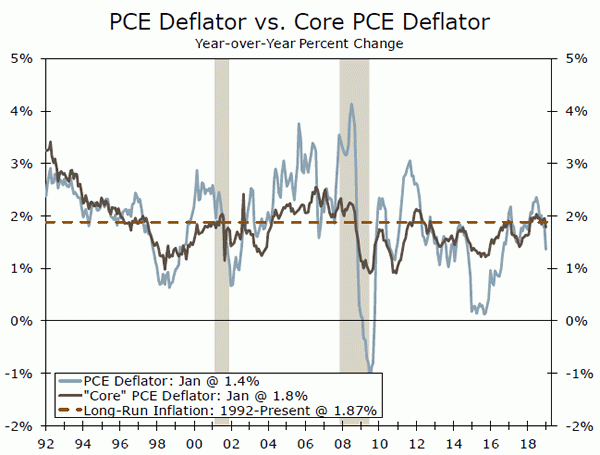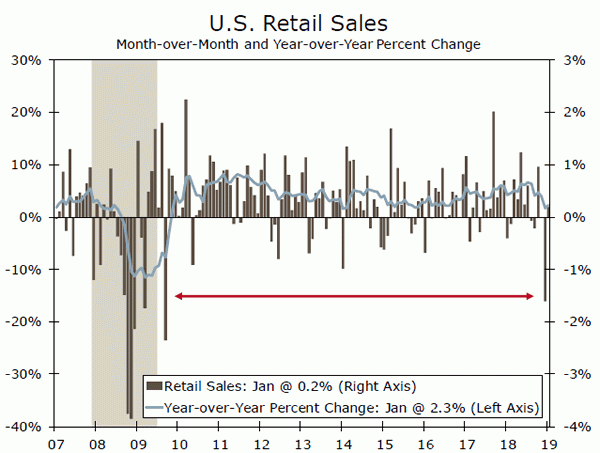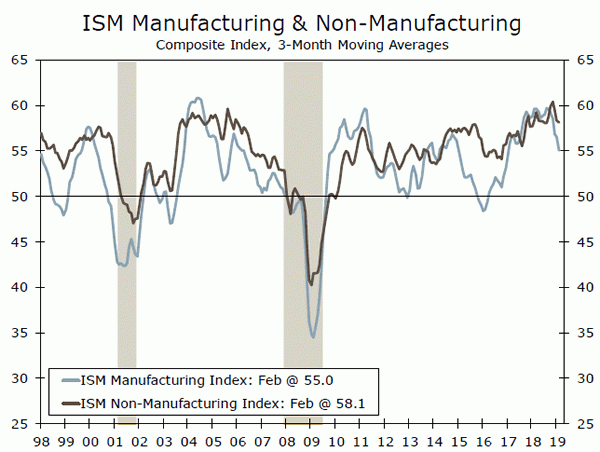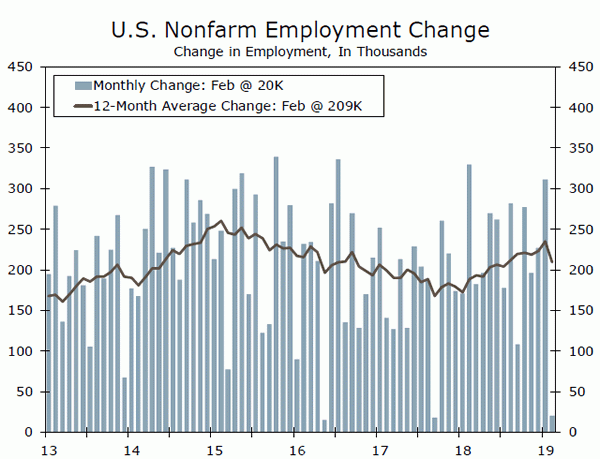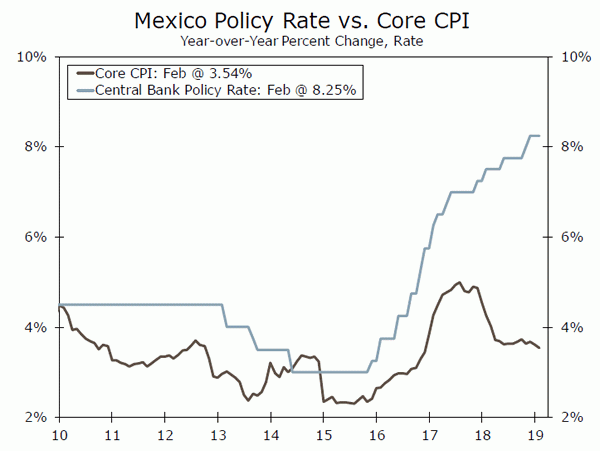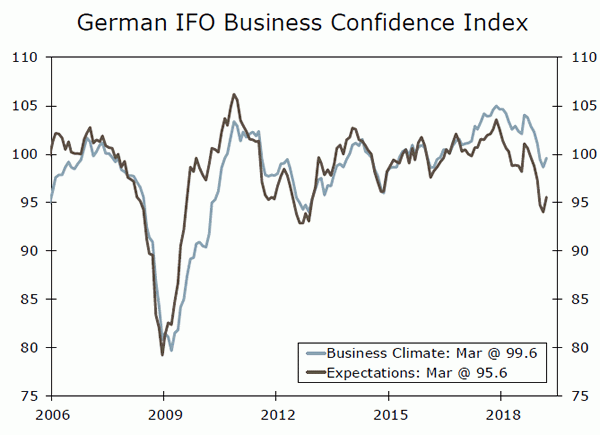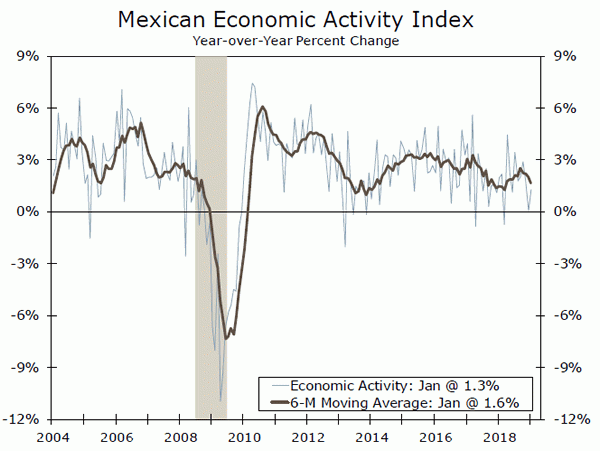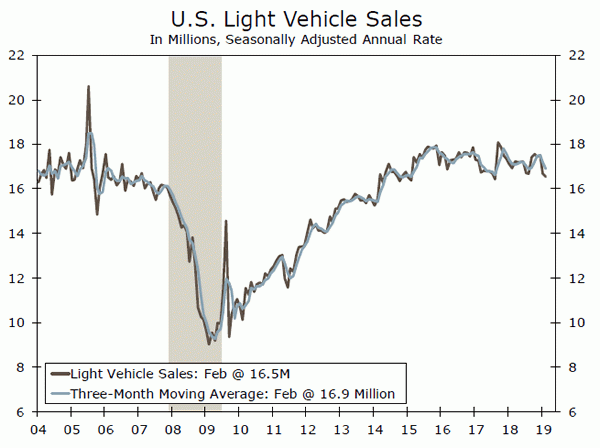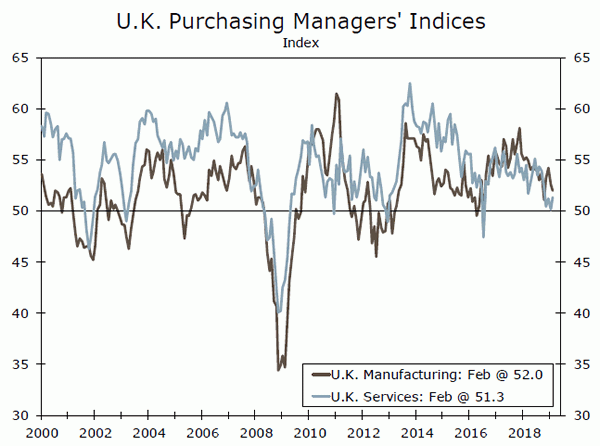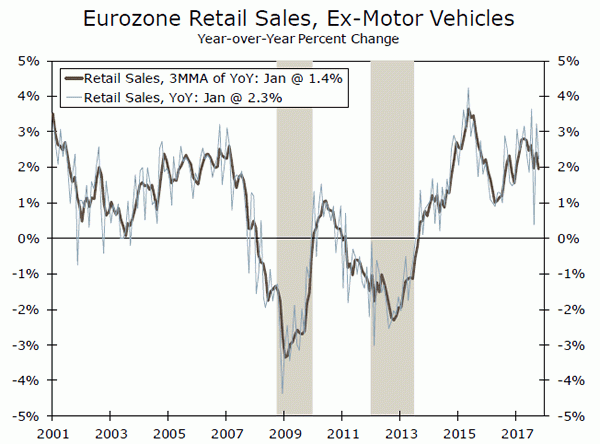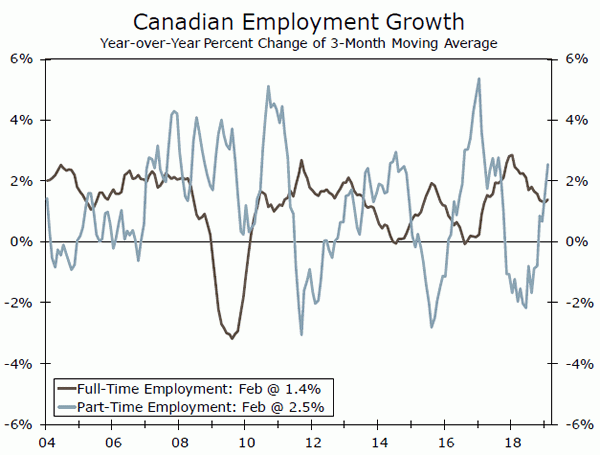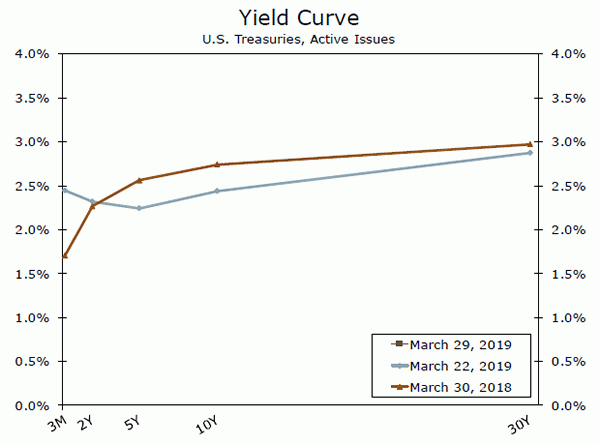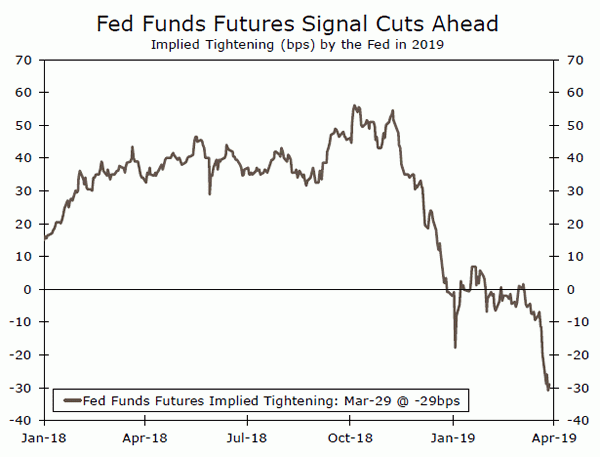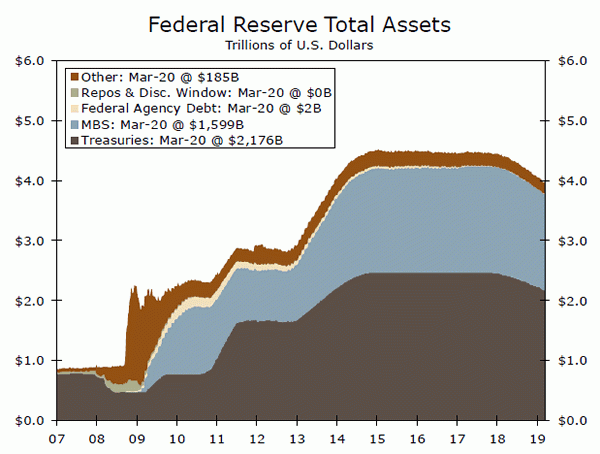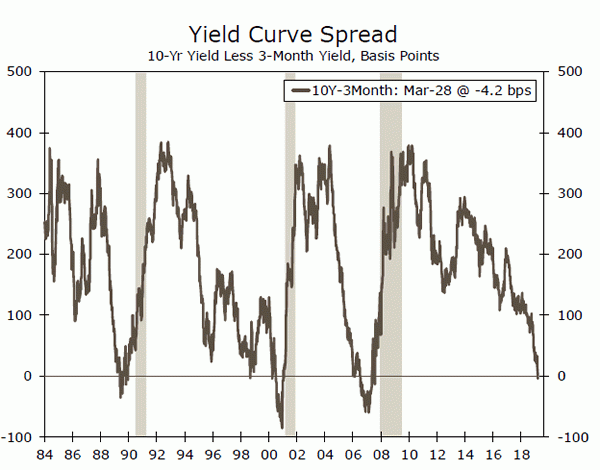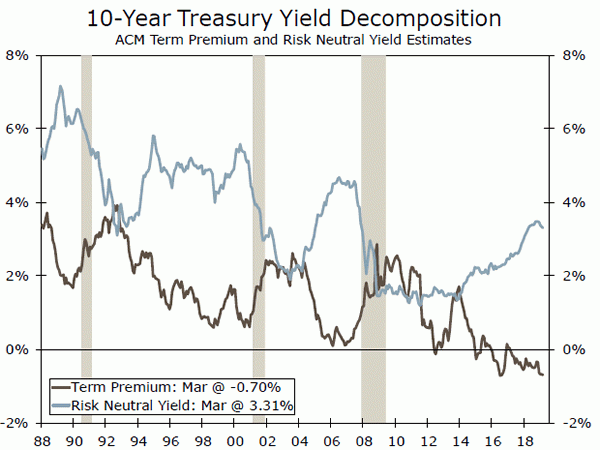U.S. Review
Resiliency in the Face of Uncertainty
- The U.S. economy continues to show a great deal of resiliency in the face of slowing global economic growth and a whole host of geopolitical uncertainty.
- Falling long-term interest rates have raised fears about a recession but have also halted the slide in home sales.
- Consumer confidence fell in March, as consumers expressed less optimism about employment conditions. Plans to purchase cars and homes both rose notably.
- Regional production indices weakened in March but remain at levels consistent with modest economic growth.
What Lies Beyond the Soft First Quarter?
Today marks the last business day of an exceptionally soft first quarter. We estimate that real GDP grew at a 1.4% annual rate during the quarter, largely due to the weakness in consumer spending and housing at the end of 2018 and at the start of this year. The federal government shutdown also negatively impacted Q1 growth, as did weaker global economic growth and lingering uncertainty surrounding geopolitical events, such as Brexit and ongoing trade negotiations with China.
Through all of this uncertainty, the U.S. economy has continued to show a great deal of resiliency. The downward revision to Q4 GDP growth to a 2.2% annual rate effectively lowered the bar for the current quarter, which should make it easier to meet our modest growth expectations. The trade deficit also shrank sharply in January, which should boost Q1 growth.
Most data through February show the economy losing momentum. Income growth has been surprisingly weak, with personal income rising just 0.2% in February after declining 0.1% the prior month. Most of the weakness was in farm income and income from interest and dividends. Wages and salaries rose 0.3% in both January and February. Tax payments also apparently jumped in January, resulting in a 0.2% drop in real after-tax income. The softer income data may explain the recent dip in consumer confidence, which fell 7.3 points in March but remains at a fairly lofty level.
The hangover from the government shutdown has the statistical agencies playing catch-up. Only nominal income data are available through February. The latest real personal consumption data are for January and they rose just 0.1%, following a 0.6% drop in December. Much of January’s weakness in January was in durable goods, which plunged 1.6%. With incomes growing slowly, tax refunds running late and Easter falling late this year, the risks to Q1 spending are stacked to the downside for our 1.7% forecast. Any shortfall would at least partially result in higher inventories, mitigating some of the damage to Q1 growth.
Inflation continues to run slightly below the Fed’s objective. The overall PCE deflator fell 0.1% in January, and prices excluding food and energy rose just 0.1%. On a year-over-year basis, the core PCE deflator—the Fed’s preferred price gauge—is up just 1.8%. The lack of inflationary pressure gives the Fed plenty of latitude in holding off on any additional rate hikes.
Softer economic news combined with the drop in long-term interest rates has produced an inverted yield curve, with the yield on the 10-year Treasury note falling below the three-month T-bill. On an ominous note, every recession for the past 60 years has been preceded by an inverted yield curve. Every inverted yield curve, however, has not been followed by a recession.
Fortunately, the U.S. economy is slowing from a fairly strong position. Employment growth has been fairly strong, unemployment is low and household balance sheets are relatively healthy. The key areas to watch are the more cyclical areas of the economy—most notably motor vehicle sales, home sales and factory orders, all of which are losing steam.
U.S. Outlook
Retail Sales • Monday
After the largest monthly decline since the Great Recession, retail sales rose a modest 0.2% in January. Excluding volatile components, the control group rebounded 1.1% in January, but that wasn’t enough to make up for the cratering in this measure at the end of last year.
Consumer fundamentals have shown some signs of weakness. This morning we learned that income growth has been surprisingly weak, with personal income rising just 0.2% in February. Consumer confidence also slipped 7.3 points in March, indicating consumers have still not fully found their footing after the stock market selloff late last year. Given these developments and the more measured start to the year for retail sales, consumer spending looks poised to slow well below 2% in the first quarter. However, we still hold our view that this will not cause a prolonged retrenchment in consumer spending.
Previous: 0.2% Wells Fargo: 0.2% Consensus: 0.3% (Month-over-Month)
ISM Man. & ISM Non-Man. • Mon & Wed
The ISM non-manufacturing index, to be released on Wednesday, rose three points to 59.7 in February. Growth in the service sector remains firm, with the business activity index at 64.7 and the new orders index at 65.2. The ISM manufacturing index, on the other hand, slipped to 54.2 in February, the slowest pace of factory sector activity since 2016. This key gauge of manufacturing momentum appears to have rolled over. However, that has happened twice in this cycle without a subsequent recession, and despite a slowdown in manufacturing, the service sector continues to accelerate.
Though trade tension is likely to have more of an effect on the factory sector than on the service sector, a decelerating global growth environment coupled with continued trade uncertainty have the potential to weigh on activity in coming months.
Previous: 59.7 Wells Fargo: 57.8 Consensus: 58.0
Employment • Friday
Hiring slowed in February, as employers added only 20,000 new jobs. As evident in the construction, mining & logging and goodsproducing sectors, winter weather weighed on hiring. Average hourly earnings increased 3.4% year-over-year in February—a new cycle high. The unemployment rate remains low within its recent range, consistent with the downward drift in initial jobless claims reported this week.
At last week’s FOMC meeting the Fed remained dovish, as a majority of voting members predicted keeping rates on hold this year. They also decreased their projections of real GDP growth and commented on the slow rate of fourth quarter economic activity. Furthermore, the yield curve inverted at the end of last week, suggesting increased worries a recession may be imminent. With these factors in mind, we look for nonfarm payrolls to rise 160,000 in March.
Previous: 20,000 Wells Fargo: 160,000 Consensus: 175,000
Global Review
As the Clock Ticks, Still No Brexit Solution
- As the clock winds down, the United Kingdom again failed to find a path forward for Brexit this week. Parliament had an opportunity to vote on a number of alternative options but none received a majority of votes, while Prime Minister May’s deal still seems to lack enough support to pass. The risk of a nodeal exit and a general election are rising.
- It was a busy week for Mexico, where the central bank signaled it was in no rush to start cutting interest rates. High real interest rates are likely keeping a lid on growth in Mexico’s economy, which also faces challenges from flat demand for autos and ongoing declines in oil production.
Still No Clear Path Forward for Brexit
The past week featured nearly constant headlines about Brexit, and yet, despite all the back and forth, we know nothing more than we did a week ago. U.K. Parliament had a chance on Wednesday to hold a series of indicative votes on alternative paths forward for the Brexit process. These were non-binding votes, but it was widely expected that any plan favored by a majority of members of parliament (MPs) would be implemented by Theresa May’s government. However, none of the options received a majority of votes, and attention is now shifting back toward May’s original Brexit deal. May vowed to resign if her deal is approved, but that does not seem to have swayed enough MPs to pass her deal. Where does that leave things? The default legal option as it currently stands is for the United Kingdom to leave the E.U. without a deal on April 12. Before then, MPs must either approve May’s deal, propose an alternative plan to deliver Brexit or seek a longer extension to the Article 50 deadline (perhaps several years), which could open the door to new elections or a second referendum. Another round of voting and debates in parliament on alternative plans is expected to take place on Monday.
Elsewhere in Europe, activity and sentiment figures for the Eurozone were mixed but showed some green shoots. Germany’s March IFO business confidence index recovered to a still-low 99.6 (top chart), the first increase in six months, while annual retail sales growth unexpectedly perked up to 4.7% in February. Still, overall economic confidence for the Eurozone softened a bit more than expected to 105.5 in March, with declines in industrial and services confidence. Overall, it seems that the Eurozone economy will remain soft for now, and interest rates will likely remain at or near current levels for quite some time. Perhaps acknowledging that rates would remain negative for an extended period, European Central Bank (ECB) President Draghi this week noted that the central bank would consider measures to mitigate the side effects of negative rates. One option that has been discussed would be a tiered-deposit system where only a certain portion of commercial bank excess reserves would be subject to negative interest rates (currently, all excess reserves of commercial banks are subject to a rate of -0.40%). However, ECB policymakers have had mixed comments on such a policy, suggesting it is far from a done deal.
Finally, turning to emerging markets, Mexico’s central bank held its overnight rate steady at 8.25% as expected, but was more hawkish than anticipated, noting inflation risks were still to the upside. It seems the Mexican economy will not be receiving much relief from high real interest rates anytime soon. Data released this week showed economic activity rose just 1.3% in the year through January, while retail sales climbed just 0.9% (middle chart). As we wrote in a longer form piece earlier this week, Mexico’s economy is also facing weaker auto demand from its neighbor to the north (bottom chart) and continued declines in oil production. Weakness in the Mexican economy raises the stakes for the ratification of the NAFTA replacement known as the U.S.-Mexico-Canada Agreement (USMCA), currently being discussed by U.S. Congress.
Global Outlook
U.K. PMIs • Monday &Wednesday
The U.K. PMIs for March are slated for release next week (manufacturing PMI on Monday, services PMI on Wednesday), and could offer important insight into the performance of the economy during a month characterized by the most acute uncertainty over the Brexit process. The PMIs for both the manufacturing and services sectors are only modestly above 50, and somewhat at odds with surprisingly resilient hard economic data. Nowhere is that dichotomy more apparent than the services sector, with a PMI reading of just 51.3, even as retail sales have accelerated in recent months. The picture manufacturing is a bit more consistent, as output has weakened considerably and sentiment remains soft, with the manufacturing PMI currently standing at just 52.0. In our view, the longer the uncertainty of Brexit drags on, the more negative it will become for the economy, and the more it will affect the hard data and sentiment data alike.
Previous: 52.0 (Manufacturing) 51.3 (Services) Consensus: 51.3 (Manufacturing) 51.0 (Services)
Eurozone Retail Sales • Wednesday
The Eurozone economy has been slowing for several months now, and fears of a recession in the currency bloc are rising. Looking at the components of domestic demand, consumer spending has been the weakest component with sequential growth of just 0.2% (not annualized) in Q4-2018 and just 0.1% in the prior quarter. These data are somewhat at odds with the retail sales figures, which have been a bit more resilient, and are even harder to square with solid consumer fundamentals in the Eurozone. Wage growth has picked up meaningfully in recent quarters and employment growth remains solid, implying strong income growth. Inflation jumped toward the second half of last year amid higher oil prices, but has receded more recently, suggesting real incomes have improved. We remain of the view that the Eurozone will avoid recession, helped in large part by solid consumer fundamentals, and retail sales will thus be a key activity figure to watch.
Previous: 1.3% (Month-over-Month) Consensus: 0.1%
Canada Employment • Friday
Canada’s economy has shown recent signs of weakness, as Q4 GDP rose just 0.4% on a sequential annualized basis. That softness in growth has seemingly not yet fed into a weaker labor market, however. If anything, employment growth has picked up in recent months, while wage growth has rebounded and the jobless rate remains fairly low. To be sure, the mix of full-time jobs and part-time jobs has worsened a bit in recent months, but full-time job growth is still solid.
Going forward, the labor market will be a key signal to watch for whether Canada’s economy will hold up amid rising risks, including housing market weakness and still-subdued oil prices. Wage growth could be particularly important to watch given concerns around elevated consumer indebtedness, especially as it relates to mortgage debt. Solid real wage gains would help offset some of the burden of higher interest rates as consumers pay off their mortgages.
Previous: 55.9K Consensus: -10.0K
Point of View
Interest Rate Watch
What Is Going on in the U.S. Treasury Market?
U.S. Treasury markets have been on a wild ride over the past week or so. Treasury yields on securities maturing between two and ten years have fallen about 25 bps since the day before the Fed meeting, accelerating what has already been a steep decline in yields over the past six months. As recently as November, the 10-year Treasury was yielding about 3.25%, while today it stands just below 2.40%.
A softer growth and inflation outlook has likely played a role in the falling yields, but the biggest driver has probably been the extent to which all future Fed tightening has been removed from the bond market. Back in November, fed funds futures implied that markets were pricing in a bit more than two rate hikes in 2019. Today, fed funds futures imply markets are priced for a bit more than one cut in 2019. This amounts to a net swing of roughly 80bps (middle chart), a significant move that has weighed on yields across the Treasury curve. Going out a bit further, the story does not change much, as fed funds futures currently imply roughly another 40 bps in easing in 2020.
A secondary driver was the Fed’s somewhat dovish approach to ending balance sheet reductions. The Fed announced last week that it would stop reducing the size of its balance sheet at the end of Q3; our forecast had been for the unwind to end one quarter later. Furthermore, the Fed chose to reduce the cap on its Treasury redemptions by $15 billion a month starting in May. Though individually neither of these moves were particularly large, their cumulative impact was probably enough to reduce the supply of Treasury securities available to the market in 2019 by roughly $150 billion relative to our baseline.
Will yields continue to decline? We believe the answer is no. We do not expect the Fed to cut rates in 2019, and we expect foreign central banks like the European Central Bank and the Bank of England to begin tightening either late this year or in the first half of 2020. That said, it will be difficult for yields to rise too much unless expectations for Fed policy dramatically reverse course or the term premium reemerges from hibernation.
Credit Market Insights
Mortgage Rates Head South
The average rate on a conventional 30-year mortgage fell 22 bps over the past week, the largest weekly decline since 2008. After reaching a cycle high of 4.8% in November, rates have plunged to 4.1%, bringing residential financing costs down to the lowest level in more than a year.
The Fed’s dovish pivot has reverberated throughout credit markets worldwide. Sovereign bond yields across the developed world have fallen dramatically in recent weeks as investors sift through indications of weakening economic momentum and shifting central bank intentions. The 10-year Treasury yield has fallen below 2.4% and now sits below the yield on the three-month T-bill. While the inversion of the yield curve will spark fears of a recession, the outlook for the housing sector during this key buying season has become sunnier. Mortgage applications bounced 8.9% last week and should continue to trend up as lower rates filter through to prospective buyers. With prices stretching affordability so thin, a drop in rates— particularly of this magnitude—can induce marginal buyers to re-enter the market. We have also seen a surge in refinancing activity as homeowners aim to lock in these lower rates. Implied interest rate volatility has surged this past week as markets increasingly price in a Fed rate cut, despite officials maintaining they are merely on hold. Nevertheless, the decline in mortgage rates is significant, and should be sufficient to stem the decline in housing we observed through the end of last year.
Topic of the Week
Inverted Yield Curve: Is It Different This Time?
Yields on 10-year Treasury notes fell below yields on three-month Treasury bills at the end of last week, resulting in an inversion of this measure of the yield curve for the first time since 2007. The front-end of the curve inverted in December, but the inversion of the 10-year/three-month is a more widely recognized omen for recession. This week, we examined the recent inversion of the yield curve and what it suggests for economic growth—is it different this time?
First, the degree of yield curve inversion at present is insignificant relative to prior cycles. Putting the recent inversion of the yield curve into perspective, the curve inverted 17 months before the start of the Great Recession, and the spread fell to as much as -60 bps in early 2017. During the previous cycle, the curve inverted eight months before the start of the recession, and the spread fell to nearly -100 bps in late 2000. The curve would need to invert significantly and remain inverted for weeks, if not months, before it would be a reliable recession signal. Recent comments from Dallas Fed President, Robert Kaplan, and St. Louis Fed President, James Bullard, reiterate this point. In an interview this week, Kaplan said, “I’d need to see an inversion of some magnitude and/or some duration,” while Bullard said on Thursday, “I think you would have to get a wider variety of spreads to be inverted…and it would have to stay inverted and be meaningfully inverted for a while” when discussing if the recent inversion was a negative signal.
There is also some question about unique factors that may make the yield curve more dynamic compared to prior inversions. The purchase of Treasury securities by the Fed as part of its quantitative easing program collapsed the term premium on longer-dated Treasury bonds. That means the yield on the 10-year Treasury is arguably lower than it otherwise would be.
Furthermore, the yield curve is really the only indicator signaling trouble at present. We would need to see further sustained inversion along with generalized restriction in financial conditions in conjunction with deterioration in economic fundamentals before we become truly worried.




